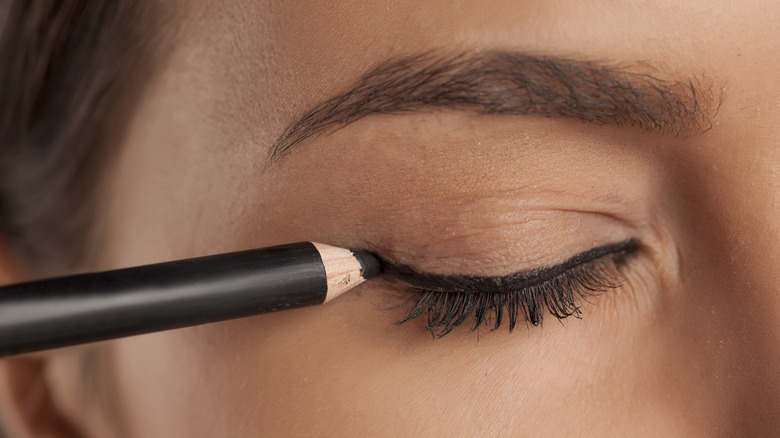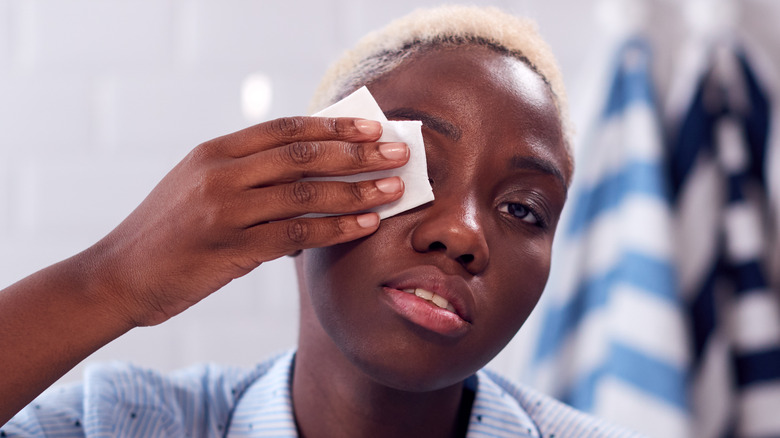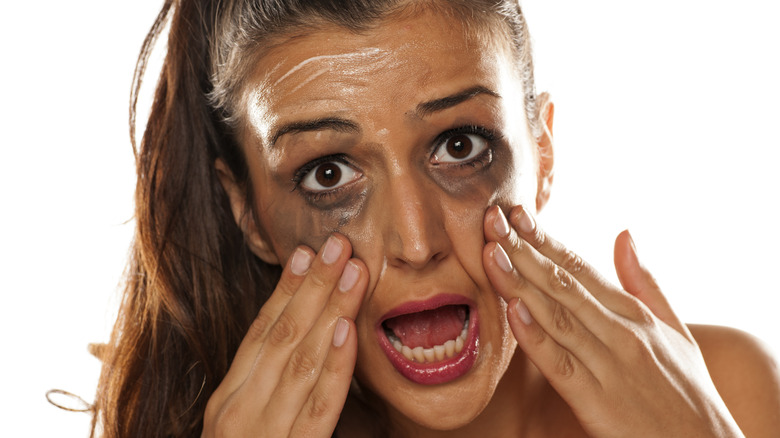Removing Waterproof Eyeliner Is Easy If You Follow Our Advice
If you're the type of person who prefers to wear eyeliner at all times, you know how important it is for it to be waterproof. Eyeliner that is formulated to be waterproof is specifically made to prevent smudging and running due to moisture. This means you have one less thing to worry about when you head out the door for the day, knowing your look is budge-proof.
That being said, the end of the day can be a totally different story. Of all the makeup you'll want to remove after the day is done, your waterproof eyeliner might give you the most difficulty. Because of its water-resistant formula, it can be challenging to get rid of, especially if you layer it on your waterlines. As a result, you might be tempted to just sleep it off — literally — or hope it fades in the shower.
However, there can be serious side effects as a result of wearing eye makeup for longer than intended. As the Cleveland Clinic explains, limited research has shown that eyeliner, specifically when applied along the waterline, can create problems for those who wear contact lenses, as well as anyone with dry eye syndrome or sensitive eyes. Sleeping with eye makeup, in particular, can also result in the cosmetics making their way into your eyes and causing irritation, per HuffPost. Here is advice on how to easily remove your waterproof eyeliner.
How to remove your waterproof eyeliner
Before you begin removing your waterproof eyeliner, you'll want to gather all of the supplies you'll need to prepare. Cotton swabs, cotton pads, makeup wipes, eye makeup remover, and micellar water or a cleanser should be in your arsenal.
To start, dip a cotton swab in the micellar water or cleanser. Then, begin to run the swab over your eyeliner to begin to lift it from your skin. For the next step, you can continue using a cotton swab or switch over to a cotton pad. Again, dip the cotton swab into your eye makeup remover, or soak up a bit of it with a cotton pad. Gently use the swab or pad to remove as much of your eyeliner as possible. Once you're finished, grab one of your makeup wipes, and gently rub away any remaining eyeliner — voilà!
If your waterproof eyeliner is particularly stubborn, allow your makeup remover to sit along your waterlines and lashlines for at least 10 seconds. This will give your cotton swab the best shot at removing your eyeliner the first time around. You can also try a cleanser that doubles as a facewash to give yourself a deep clean before the makeup removal process. Just be mindful of your skin type; for example, a gel formulation may be better for oily skin, while a light foam might work best on dry skin.
Advice for making waterproof eyeliner removal easy
As previously mentioned, there are real consequences associated with wearing your eye makeup for extended periods of time or sleeping with it. "Sleeping in eye makeup repeatedly may result in the clogging of the tiny hair follicles and oil glands on your eyelids," dermatologist Dr. Eric Schweiger told HuffPost. "When these areas become clogged, bacteria can build up and cause inflammation. As a result, small bumps called styes or hordeolum can form. These bumps may resolve spontaneously, but many require treatment from your doctor."
If you dread the idea of removing your waterproof eyeliner at the end of the day, there are a few tricks you can use to make it less stressful. An oil-based eye makeup remover, for example, can be more effective on eyeliner that refuses to budge. Additionally, there are items that might even be in your kitchen cabinet that can help. Some eye makeup remover alternatives include coconut oil, jojoba oil, and olive oil. In your medicine cabinet, products that might get the job done include petroleum jelly, aloe vera, and cold cream.
In the event that you notice eye irritation as a result of wearing your waterproof eyeliner for a tad too long, remove it as soon as possible. Contact your doctor or ophthalmologist if you notice eye irritation, redness, or swelling that does not subside.


